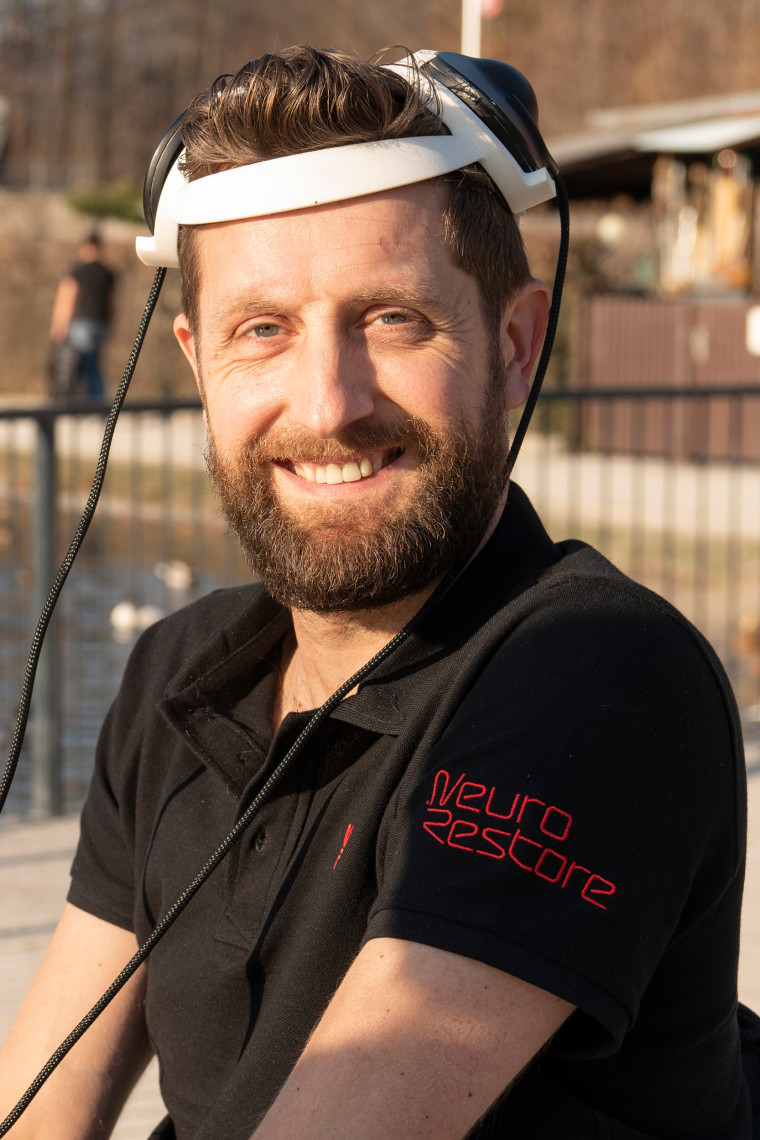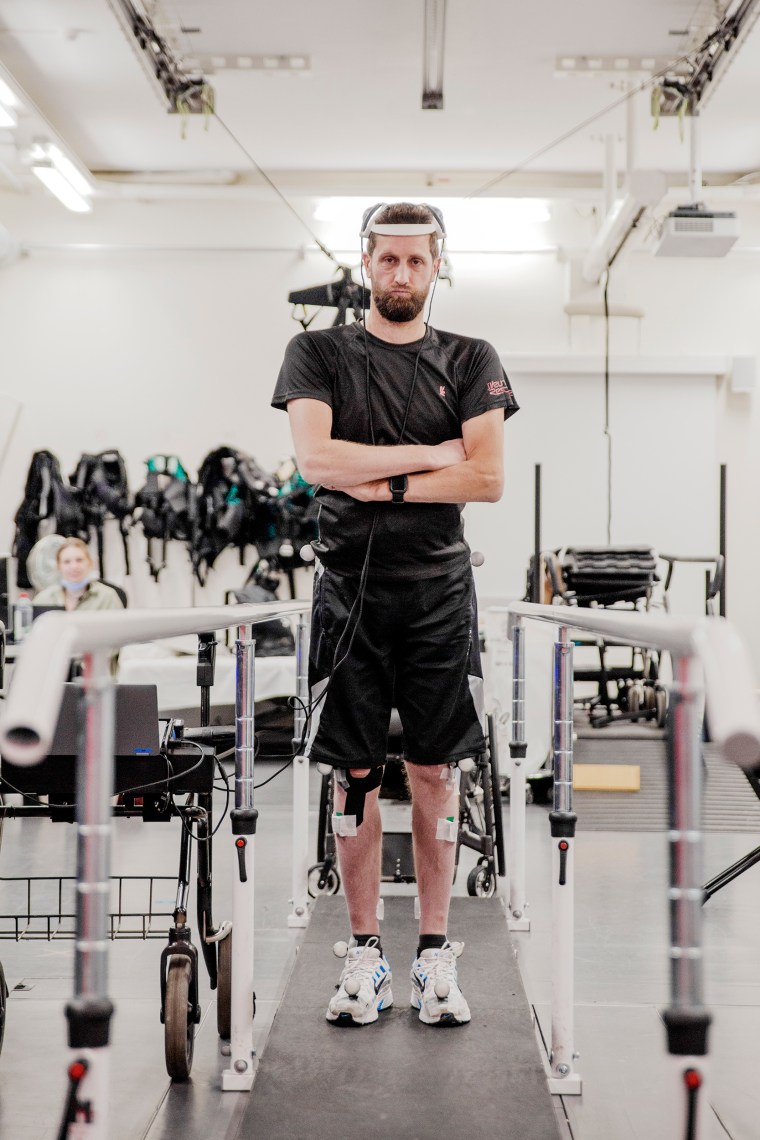A 40-year-old man whose legs are paralyzed is able to climb stairs, move over ramps and switch from standing to walking, thanks to implants in his brain and spinal cord that pair with external devices to translate his thoughts into movement.
The experiment was part of a proof-of-concept study published Wednesday in the journal Nature.
The patient, Gert-Jan Oskam, suffered a spinal cord injury from a motor bike accident 12 years ago.
“When we met him, he was completely paralyzed, unable to take a step by himself without assistance,” said Grégoire Courtine, the study’s author and a neuroscientist at EPFL, a research university in Switzerland.

In 2017, Oskam received an experimental implant in his spinal cord as part of a different clinical trial, which helped him regain his ability to walk. By lifting his heel slightly — which he could do on his own — Oskam would trigger an electrical current that stimulated nerves in his spinal cord to allow him to take steps.
But those steps were clunky, and he couldn’t navigate around obstacles or walk on uneven surfaces.
“I felt like with every step a bit stressed, like I had to be in time with the rhythm, otherwise I wouldn’t make a good step,” Oskam said during a call with reporters on Tuesday.
And, after two years of this electrical nerve stimulation, as the approach is known, Oskam’s recovery plateaued. So he joined the proof-of-concept study in 2021.
The system is different from existing technologies in its ability to translate brain signals into movement.
When Oskam thinks about moving his legs, the implant in his brain sends a signal to an external computer, which Oskam wears as a backpack. The computer then processes and relays that signal to a pacemaker in Oskam’s abdomen, which in turn sends electrical pulses to the older implant that was already in his spinal cord. That prompts Oskam’s legs to move. A helmet with two antennas helps the implants stay connected to the computer.
Older technologies that use electrical nerve stimulation, while studied more, have relied on tiny movements from the patient or the click of a button to help the patient walk.
Henri Lorach, another EPFL scientist involved in the research, told reporters that by using the new system, Oskam could walk naturally after several minutes of training. He also gained more control over his leg movements and was able navigate tricker terrain, like gravel paths.
“The stimulation before was controlling me, and now I’m controlling the stimulation,” Oskam said.
He added that he can now walk 100 to 200 meters (around 330 to 660 feet) per day and stand unsupported for about two or three minutes.
“Last week, something needed to be painted and there was nobody to help me so I took the walker and the paint and I did it myself while I was standing,” he said.
How much mobility can a person gain?
Peter Grahn, an engineer at Mayo Clinic’s department of neurologic surgery who was not involved in the new study, said an obvious advantage to the technology is that it’s less cumbersome than exoskeleton devices, which support walking via bulky metal frames.
“A lot of devices have shown improvement in people with spinal cord injury, but then people go home and that device sits in their closet,” Grahn said.
Oskam’s steps are still slow, but Courtine said future versions of the technology might someday allow him to move faster.
The researchers noted that during the study, Oskam regained the ability to walk with crutches even when the technology was turned off. They believe the implant system may have activated pathways in his brain that had gone dormant but were still anatomically intact.
“What these technologies do is maximize existing hardware, basically, in the nervous system. What happens, we believe, is that by reactivating these pathways, they strengthen them,” said Marco Capogrosso, an assistant professor of neurological surgery at the University of Pittsburgh.

Capogrosso, who assisted with an earlier version of the research that tested the new technology in monkeys, published a paper last year demonstrating that electrical nerve stimulation can help people regain arm and hand movement after a stroke. But it’s unclear if the new technology would work well for people with more severe paralysis, he said.
Megan Gill, an assistant professor of physical therapy at the Mayo Clinic who also wasn’t involved in the study, similarly said it’s hard to tell how much the technology affected Oskam’s recovery, given that his injury was moderate and he underwent rehabilitation prior to the study.
The implant system “isn’t taking someone completely paralyzed from lying in bed and not moving to up and walking,” Gill said. “This person had some ability to stand. They had some ability to walk even before this technology was implanted.”
What’s more, Grahn said, most people with paralysis haven’t had the electrical nerve stimulation that Oskam received, which makes it difficult to know how well the technology would work in other cases.
“Technologically, I’m kind of floored by this paper, but for real-world application, there’s a lot of challenges,” he said.
Courtine was more optimistic.
“There is no reason why it would not apply to the vast majority of people with spinal cord injury,” he said.
Courtine pointed to his own previous research, which found last year that a form of electrical nerve stimulation without a brain implant helped three people without independent motor function regain their ability to stand and step.
“There is no reason why, if you add the brain control, it will not be much, much better,” he said.
When could paralyzed patients get access to this technology?
Dave Marver, the CEO of Onward, the medical technology company that’s developing the new system that Oskam uses, said the company has additional trials planned over the next 12 to 18 months. Two people will receive implants in an effort to help them walk, and two others to restore hand and arm function, he said.
Marver estimated that the system could become commercially available in four to seven years, though it would first need Food and Drug Administration approval. He said that Onward plans to work with the Centers for Medicare and Medicaid Services to get the technology covered by insurance.
“The average cost over a lifetime to support somebody with tetraplegia is $5 million,” Marver said. “If you could introduce something that’s $25,000 to $50,000, you can imagine over time that saves Medicare [or] private payers quite a bit of money.”
Gill, however, noted that clinicians would need training on how to use the highly technical system.
“As a physical therapist, if someone walked into my gym and had this thing implanted, I would have no idea what to do with it,” she said.






